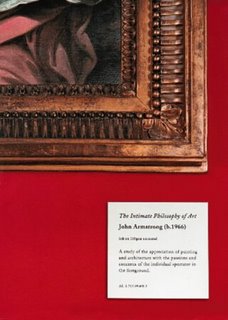The Intimate Philosophy of Art
 Hace un par de meses compré un libro llamado "The intimate Philosophy of art". En la tapa dice: "A study of the appreciation of painting and architecture with the passions and concerns of the individual spectator in the foreground". El autor, John Armstrong (b.1966), basa su visión en la idea de que las obras de arte no deben ser evaluadas en función de la información que pueda obtenerse sobre ellas sino por vía directa, es decir, por la relación de sensualidad y sentido que surja entre ella y el receptor. Me pareció un punto de vista saludable, sobre todo porque es una clara oposición a la costumbre (característica del arte contemporáneo) de creer que la obra es un ensayo de ideas, y además, uno por lo general precario y banal.
Hace un par de meses compré un libro llamado "The intimate Philosophy of art". En la tapa dice: "A study of the appreciation of painting and architecture with the passions and concerns of the individual spectator in the foreground". El autor, John Armstrong (b.1966), basa su visión en la idea de que las obras de arte no deben ser evaluadas en función de la información que pueda obtenerse sobre ellas sino por vía directa, es decir, por la relación de sensualidad y sentido que surja entre ella y el receptor. Me pareció un punto de vista saludable, sobre todo porque es una clara oposición a la costumbre (característica del arte contemporáneo) de creer que la obra es un ensayo de ideas, y además, uno por lo general precario y banal.
Cito un párrafo: "Two characteristics seem crucial when used in connection with art: magnetism -the force of fascination- and intimacy -the sense of being engaged in an especially personal and private way. And to speak of affection for a work of art is to make the salutary reminder that paintings and buildings can provoke intimate fascination. Salutary because the language of art-historical scholaship and the often grand public setting of arte can encourage an impersonal attitude".
Lo peor son siempre las actitudes impersonales, recordémoslo.

